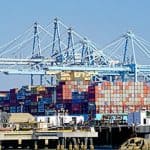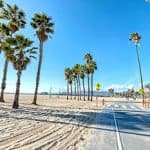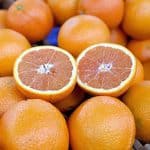
If there’s one thing San Francisco locals demand, it’s excellence from their sports teams. And most of the time, they get it. The NFL San Francisco 49ers football team has had their share of Super Bowl wins and legendary players. But as the 49ers don’t even play in the city any longer (more on that later), it’s the San Francisco Giants baseball team that is most dear to the hearts of the city’s sports fans.
You can watch the San Francisco Giants play at Oracle Park, which makes Third and King Streets in the city’s China Basin area ground zero for Bay Area Giants fans. That’s where you’ll find Oracle Park, the Giants’ home field since 2000, and the site of their 2010, 2012, and 2014 World Series victories.
Giants fans are proud and passionate, and taking in a home game at Oracle Park allows visitors to mingle with locals in an iconic bayside ballpark that’s like no other in the country. Whether you buy a ticket for a game or simply stroll the grounds around the park, no trip to San Francisco is complete without a visit to Oracle Park. Let’s take a look at the home of the San Francisco Giants more in-depth.
Taking in Oracle Park
A mere six-minute walk from the heart of downtown, Oracle Park occupies a unique location right on the San Francisco Bay. The three-tiered grandstand that extends from behind the home plate to both foul poles, plus additional bleacher seats behind left and right fields, can seat 41,000 fans. There are, in fact, no bad seats in the house, and watching a game in the evening as the setting sun colors the bay and beyond is truly an “only in San Francisco” experience.
Whether in the stands, on the outside concourses, or even in the bay itself, game days are a whirl of activity. The main gate at Third and King is positively electric with fans arriving for the game. The famous Willy Mays statue at the intersection not only honors the greatest Giants player of all time but serves as a popular fan meeting and selfie spot. In fact, mingling at Willy Mays Plaza before the game is almost as much fun as the game itself.
Visitors are advised to arrive early to the park to allow for parking or to dine in any of the fine restaurants and pubs in the immediate area. Enjoying a pregame beer and pub grub with Giants fans in a raucous Irish bar is the best way to put yourself in a Giants frame of mind, which only heightens when you step through the entrance gates.
Helpful hint: Of Oracle Park’s four entry gates, the Second Street gate is always the least crowded.
Inside Oracle Park

Once inside the park, visitors and locals marvel at the eye candy they see. Whether it’s the giant baseball mitt and Coke bottle in left field, the massive state-of-the-art scoreboard, or the cable car whose bell rings with every Giants home run, there’s something to see everywhere you look, and that’s not counting the fantastic bay views.
“Triples Alley,” near center field, is the deepest part of the park at 421 feet. Three hundred thirty-nine feet from home plate is the left field wall and the right-field wall is 309 feet. That’s where you’ll find the “Levi’s Landing Splash Zone,” where balls that clear right field splash down in the waters of McCovey Cove just behind the park.
Watching kayakers in the cove scrambling to net the home run ball is always a delight. Despite being a tempting target, as of September 2020, only 83 “splash hits” have hit the cove since 2000.
Baseball fans will want to visit the Promenade Level behind the home plate where the Giants’ World Championship trophies and rings from 2010, 2012, and 2014 World Series-winning seasons are on permanent display.
A Foodie Home Run
Taking time to walk around the inside of the park either before or during the game is always a fun and rewarding experience. The perspective and views change from place to place, and you’ll eventually find yourself in the food court. Not surprisingly for a city that prides itself on being a foodie mecca, the dining choices at Oracle Park are second to none.
While Dungeness Crab sandwiches and garlic French fries top the popularity list, fresh and locally grown salads and other healthy fare is also available, as are excellent beers and wine from local breweries and wineries. You can even visit the garden where many vendors grow their fresh and sustainable ingredients.
Bay Area Answers Fun Fact: No major league baseball player has ever hit a home run ball that landed in the 26-foot-high baseball glove that towers over left field 501 feet from home plate. Oracle Park’s longest home run was a 499 feet monster hit to center field by Giants superstar slugger Barry Bonds during the 2002 season.
Other Posts of Interest
- Is Mount Tamalpais Worth Visiting?
- Where Does The San Francisco Symphony Play?
- Is San Francisco In Silicon Valley?
- What Was Treasure Island Used For?
For the Kids
Nine innings can seem like an eternity for parents with fidgety kids. Fortunately, the “Coca Cola Fan Lot” in the left field concourse is a great way to keep the kiddies occupied.
There are four slides inside of that giant Coke bottle (which dances with light when a Giants player hits a homer), and the Little Giants Park allows kids to hit whiffle balls and run the bases in a 50 x 50 foot replica of Oracle Park. There’s also a fun photo booth and an autograph wall where kids can take rubbings of their favorite players’ autographs.
What’s Around the Park?
Regardless of whether you have purchased tickets to a game or not, first-time visitors should take the time to explore the area surrounding the park. Giants Promenade just behind center field is a fun, lively place, especially when a home game falls on a Friday (or “Orange Friday,” as locals like to call it) when bands play and local brew flows until the game begins. While there, get in line to take a selfie with the famous sculpture of Giants mascot Lou Seal.
From there, you can stroll the sidewalk behind right field and take in the kayakers, yachters, and corporate party boats that dock in McCovey Cove, all waiting for that elusive home run to clear the right field wall before landing in the splash zone. Also unique to Oracle Park is the wrought iron fence in the right field wall that lets fans without tickets watch the game as it happens.
Giants history is never far from your mind as you explore the outside of the park, as the “Giants Wall of Fame” features plaques along the King Street side of the building that highlight the achievements of legendary Giants players. A sidewalk behind the park also commemorates great Giants moments and players.
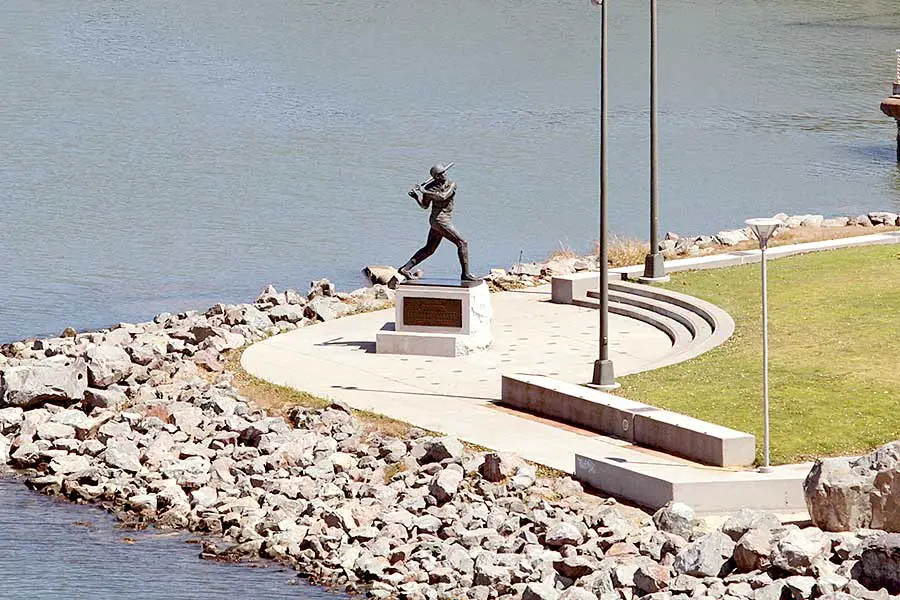
Across the cove, the statue of Giants legend Willy McCovey is worth a quick visit, as it offers outstanding selfie opportunities from every angle. The McCovey sculpture is one of five on the Oracle Park grounds that honor some of the greatest players in Giants history. Besides McCovey and Mays, Gaylord Perry, Orlando Cepeda, and Juan Marichal are also honored.
A Brief History of Oracle Park
From 1958 to 1999, the Giants played at Candlestick Park, just south of the city, a venue they shared with the NFL 49ers. “The Stick” was cold, windy, and after years of harsh weather, falling apart.
In 1996, San Francisco voters passed a ballot measure that approved the construction of a new city ballpark, originally known as Pacific Bell Park, and the Giants played their first home game in April 2000. The park was instantly a hit with fans, players, and architects who praised its classic brick and steel façade, open-air design, and expansive bay views.
The 49ers, in the meantime, continued to play at Candlestick Park until 2014 when they moved to Levi’s Stadium, 50 miles from San Francisco in the South Bay city of Santa Clara. The goal had been to build a football stadium in San Francisco, but when the city and the team couldn’t agree to terms, the 49ers jumped at Santa Clara’s offer to build a sparkling new stadium down south. Should they now be called the Santa Clara 49ers? That’s a Bay Area debate that may never end.
Oracle Park Tours
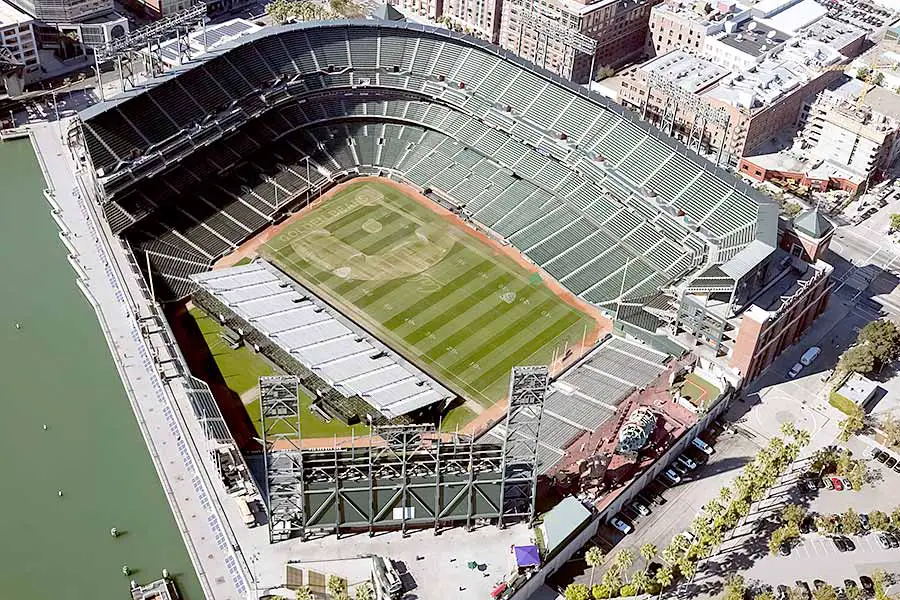
Oracle Park offers several annual public and private tours of the park where visitors can enjoy access to the dugout, visitors’ clubhouse, the field itself, and game-day batting practice. The park conducts 300 private tours annually, and in 2019, a record 37,000 visitors toured the park, so you may want to book ahead. Click here for more tour information and prices. For details on buying single-game tickets for a Giants game, click here.
How to Get to Oracle Park
Thanks to its centralized downtown location, Oracle Park is easy to reach. For those who must drive, parking lots are plentiful, but they’ll cost you a pretty penny on gameday. Visitors heading to the park from downtown hotels or cruise ships docked at Pier 27 are advised to simply take the short, 15-minute walk to the park. Cabs and ride shares are also available, and the park offers a valet service for bike riders.
Public transportation includes the MUNI Metro F and N streetcar lines that cruise along King Street, and the Caltrain commuter train line offers transportation options for those coming from the southern peninsula communities. Click here for a complete transportation guide.
Summing It Up
Whether you’re a baseball or sports history fan or someone who loves classic, throw-back sports architecture, Oracle Park should top your list of places to visit. It’s especially ideal for sports fans whose summer vacation plans include visiting ballparks in other U.S. cities.
The park’s rich history, classic design, and breathtaking bay views are like no other sports venue in the country, and even if you don’t go inside the park, the surrounding area offers lots to do and see.


